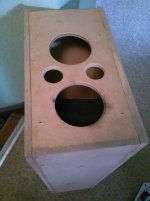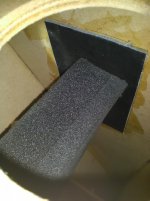"When building boxes from 3/4 inch thick wood, then the un-braced areas should be less than 4 inch squares to obtain high stiffness and to push panel resonances into the kHz region and where they can be decoupled from the driver's structure and airborne vibration." Siegfried Linkwitz
One thing that I'd be tempted to do is have one side made thicker than the other to avoid the " tuning fork effect ".
It might be difficult to imagine that damping can be very effective even without bracing.
If you watch this 30 sec vid, keep in mind that these are dampers, not braces and function while allowing movement.
Dampers for earthquake protection - YouTube
If you watch this 30 sec vid, keep in mind that these are dampers, not braces and function while allowing movement.
Dampers for earthquake protection - YouTube
I'd argue that they are in fact braces. The way they function is different than a "stiff" brace would be.
As it pertains to a speaker box, the question is whether a reduced amount of wall movement trumps a totally stiff design allowing no movement. As shown in the video, a continued motion, as a driver would produce, doesn't eliminate movement.
As it pertains to a speaker box, the question is whether a reduced amount of wall movement trumps a totally stiff design allowing no movement. As shown in the video, a continued motion, as a driver would produce, doesn't eliminate movement.
Last edited:
Define " totally stiff ", a 10 tonne bell would be considered totally stiff, doesn't stop the ####ing things from ringing.
What if the platform had been moving at audio frequencies?As shown in the video, a continued motion, as a driver would produce, doesn't eliminate movement.
The video would have been more entertaining?What if the platform had been moving at audio frequencies?
The video that Allen B posted shows a low rigidity structure which has had carefully tuned damping added. The damping was tuned so that the mass, stiffness, and damping produce (what appears to be) a critically damped response at the resonant frequency.
Critical damping is extremely hard to achieve in real world structures (such as a six sided box made of MDF)... We should not fantasize that we can easily achieve a similar result at audio frequencies by incorporating various soft glues, foams, felt, caulking, or rubber sheets.
The typical speaker cabinet which incorporates high levels of damping, including constrained layer damping, will still produce oscillation at resonance. And this may be perfectly fine. Cabinet structural resonances are only a problem if they are audible, and the evidence seems to indicate that they are not audible unless they are pretty severe. I tend to agree with Mark100: a big wiggle on the impedance curve is probably audible, a small wiggle is probably not, and if there is no wiggle, there is probably no problem (Mark I hope I paraphrased you correctly)...
It is also my opinion that it is easier to make cabinet resonances a non-problem by making the cabinet stiff and well braced, rather than adding damping.
Critical damping is extremely hard to achieve in real world structures (such as a six sided box made of MDF)... We should not fantasize that we can easily achieve a similar result at audio frequencies by incorporating various soft glues, foams, felt, caulking, or rubber sheets.
The typical speaker cabinet which incorporates high levels of damping, including constrained layer damping, will still produce oscillation at resonance. And this may be perfectly fine. Cabinet structural resonances are only a problem if they are audible, and the evidence seems to indicate that they are not audible unless they are pretty severe. I tend to agree with Mark100: a big wiggle on the impedance curve is probably audible, a small wiggle is probably not, and if there is no wiggle, there is probably no problem (Mark I hope I paraphrased you correctly)...
It is also my opinion that it is easier to make cabinet resonances a non-problem by making the cabinet stiff and well braced, rather than adding damping.
..and for cabinet vibrations which do not interact with the driver motor?and if there is no wiggle, there is probably no problem
I like the idea of using soft glue for braces, if i cut my braces a few millimeter short and fill the gaps between brace end and the mdf panel with non hardening silicone, will this help damping panel flex, or will the silicone most likely be to soft?
my takes is a simple irregular or triangled bracing will do fine. The most important point here is try to built the enclosure with resonance outside the passband of the driver. So for Woofers cabinet closer bracing will lift the box vibration above the driver operating range. Mids box will do well with a larger box with less bracing to ensure the resonance is at a lower frequency. All box should be irregular in shape with wedges to prevent standing waves. The BnW nautilaus speaker is actually a very good enclosure to copy.
Decoupling the driver from the rigid box will reduce the remaining noise. For damping If you don't mind the hassles CLD is best. You can also use MLV decoupled from the cabinet walls with foam. MLV tend very effective above 100hz and have next to no resonance except at a very low frequency .
Decoupling the driver from the rigid box will reduce the remaining noise. For damping If you don't mind the hassles CLD is best. You can also use MLV decoupled from the cabinet walls with foam. MLV tend very effective above 100hz and have next to no resonance except at a very low frequency .

 ATTACH]
ATTACH]I agree that critically damping is difficult, as it has to be precisely tuned to the right frequency; attached are some pictures of the bass chamber of a semi omni, inside is a piece of stiff foam in compression between two rubber pads, I guess that the foam is no way stiff enough, perhaps I'll try a bit of wood with a little bit of foam at one end. One side of the box is thicker than the other, this also wasn't as effective as I'd hoped, when knocked it still sounds like a box. I might try gluing 1/4 inch thick steel pads to the rubber pads and see if that makes a difference.
cracked case, CLD is the best solution for your box. Get some viscoelastic adhesive or best greenglue as it have published application notes to follow. Cover above 70% of flat surface with a sandwich of a thinner plywood.
Bracing have to be wood to be effective n viscous glued in placed. I never like the sound of a seal box playing loud and it have to do with the backwave from speaker cone muddling up the sound. Go TL or Bass reflex and the cabinet resonaces and box coloration will become less an issue.
Bracing have to be wood to be effective n viscous glued in placed. I never like the sound of a seal box playing loud and it have to do with the backwave from speaker cone muddling up the sound. Go TL or Bass reflex and the cabinet resonaces and box coloration will become less an issue.
What about loss of micro-detail or downward dynamic range (DDR) or what ever the latest trendy term is? 😉Decoupling the driver from the rigid box will reduce the remaining noise.
my takes is a simple irregular or triangled bracing will do fine. The most important point here is try to built the enclosure with resonance outside the passband of the driver. So for Woofers cabinet closer bracing will lift the box vibration above the driver operating range. Mids box will do well with a larger box with less bracing to ensure the resonance is at a lower frequency. All box should be irregular in shape with wedges to prevent standing waves. The BnW nautilaus speaker is actually a very good enclosure to copy.
Decoupling the driver from the rigid box will reduce the remaining noise. For damping If you don't mind the hassles CLD is best. You can also use MLV decoupled from the cabinet walls with foam. MLV tend very effective above 100hz and have next to no resonance except at a very low frequency .
This is probably the correct way of doing this, but it is very appealing to try to slow down the vibration instead, in my mind a low pitched box will sound less annoying then a high pitched one
Last edited:
Define " totally stiff ", a 10 tonne bell would be considered totally stiff, doesn't stop the ####ing things from ringing.
That is such a clever - but misleading - posit, it really deserves closer attention.
First, the bell must be stimulated to sound by an enormous impulsive force from the heavy and hard kinetic energy of the clapper. And it is its main esonance (or a few natural harmonics or resonances) that get kicked into producing the chime.
Second, even if you made a speaker cab from a bell, it might possibly resonate when the driver hit the resonant freq of the bell and only then. But hard for me to imagine a driver capable of that.
Some readers may be following a very similar discussion in the subwoofers forum ("CNC..."). Endless jaw-jaw about cab vibration but never any evidence of audibility. This topic is getting boring - sometimes I even wish the forum went back to interminable arguments about edge diffraction (hint: prolly also inaudible).
B.
Last edited:
A massive tower bell can be rung by a tiny continuous excitement, either at the main resonant frequency, or at the many harmonics. A speaker driver supplies a continuous excitement. A clapper has to be heavy because it has to excite the bell to resonate at DEAFENING levels with one single strike.
- Home
- Loudspeakers
- Multi-Way
- A simple (but maybe not easy) bracing question.